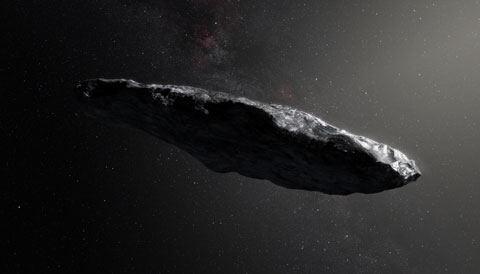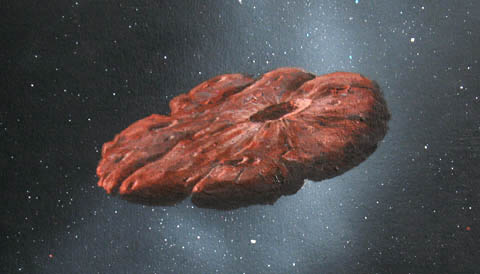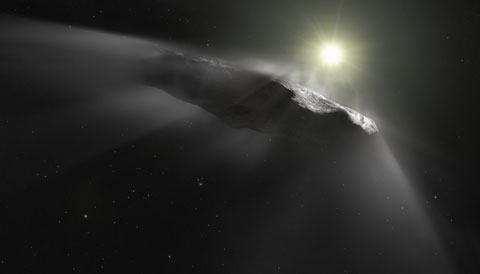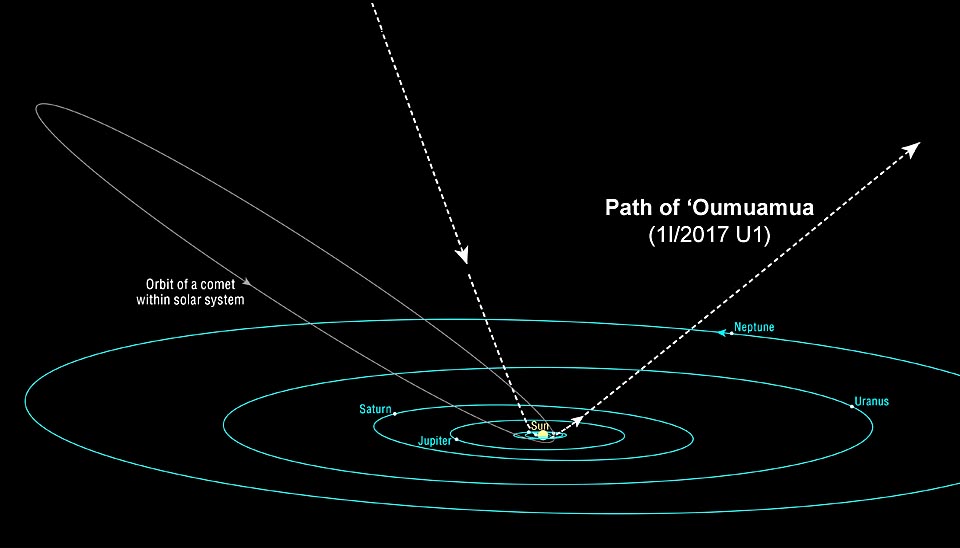‘Oumuamua’s strange trajectory can be explained if the object was a comet fragment with the density of air.

ESO / M. Kornmesser
1I/'Oumuamua, the interstellar mystery object that briefly visited the inner solar system in 2018, has proven a difficult nut to crack. Astronomers are still arguing about what it even is — asteroid, comet, or something else altogether? Now, in a pair of studies posted recently on the arXiv (paper 1, paper 2), Zdenek Sekanina (JPL-Caltech) suggests the object might be an ultra-low density fragment from a comet that disintegrated while passing near the Sun.
‘Oumuamua’s Weird Exit
Observers didn’t catch ‘Oumuamua until it was already headed out of the solar system, but intense observing campaigns in October and November of 2017 quickly pinned down its weird orbit. It was clearly hyperbolic, taking the interstellar visitor on a one-time tour around our Sun.

© William K. Hartmann
Given its brief visit, we only know a little bit about this object: Photometry showed that it is red, and a light curve showed that it's likely tumbling as it goes. But we have no direct images — the object might be cigar-shaped, pancake-shaped . . . or maybe it's an alien light sail. (Yes, even that last one is a scientific suggestion, albeit a controversial one!)
The object passed Saturn’s orbit in January, and it’s long been out of range of even the best telescopes, but that doesn't mean we’re done with it yet. Marco Micheli (European Space Agency) and colleagues obtained such good measurements of its trajectory out of the inner solar system that in 2018 they were able to say unequivocally that gravity wasn’t the only force guiding its path outward. The results required some kind of extra force — aka, a non-gravitational acceleration — and now it’s up to theorists to say what that force might be.

ESA / Hubble / NASA / ESO / M. Kornmesser
If ‘Oumuamua were a comet, the answer would be obvious: Ices sublimating off the surface as it neared the Sun would have created jets that might have tweaked the object’s trajectory. But here’s the rub: Observations didn’t find any signs of activity. In fact, infrared observations from the Spitzer Space Telescope pretty much ruled out the release of carbon monoxide or carbon dioxide — two compounds commonly found in comet tails.
But because other possible explanations seemed so outlandish, many astronomers continued to cling to the comet scenario. After all, a small amount of outgassing might have evaded detection. A recent paper by Darryl Seligman and Greg Laughlin (both at Yale) suggested that the sublimating ices might have been entirely water, producing a nozzle-like jet that swung like a pendulum, which made the whole cigar-shaped comet rock in turn.
Ruling Out Outgassing
But there are problems with that explanation, writes Sekanina.
First, a look at comets coming from the solar system’s Oort Cloud — a place likely similar to where ‘Oumuamua came from — shows that such objects don’t have the amount of water ice needed to explain ‘Oumuamua’s trajectory. Moreover, the outgassing that does occur turns these comets into fuzzy dots, in stark contrast to ‘Oumuamua’s star-like appearance in images. Then there’s the fact that active Oort Cloud comets don’t accelerate the way ‘Oumuamua did. The nail in the coffin, though, is that water ice — even if present — couldn’t have sublimated quickly enough to spur ‘Oumuamua on its way.

Brooks Bays / SOEST Publication Services / Univ. of Hawaii
So if not comet-like activity, then what drove ‘Oumuamua’s non-gravitational acceleration? The remaining force under consideration is solar radiation pressure. For the Sun’s photons to push ‘Oumuamua fast enough to explain its acceleration, though, the object itself would have had to have a density less than 0.0015 grams per cubic centimeter — effectively light as air.
Sekanina has proposed a scenario to create such an ultra-low density object: Before we ever saw ‘Oumuamua, it was part of an interstellar comet. As the comet approached our Sun — after billions of years spent traveling between stars — it disintegrated. By the time our telescopes picked it up, ‘Oumuamua was a mere fragment left over from an epic journey.
“Shortly after the Micheli et al. paper came out, somebody suggested to me that we might be seeing solar radiation pressure,” Bill Gray (Project Pluto) shares. “I immediately replied, ‘Nah. Can't be. The object would have to have an absurdly low density for that to work.’”
“But,” he adds, “I think Sekanina makes a good case for that to be exactly what we're seeing here, along with an explanation of how you get an object with that low a density.”
“The article by Zdenek Sekanina is certainly intriguing,” says Seligman. He acknowledges Sekanina's argument that ‘Oumuamua indeed did not receive enough energy from the Sun to power the outflow of sublimated water molecules. Now, Seligman and Laughlin are exploring some other scenarios, including the possibility of a fragment composed primarily of molecular hydrogen ice, a material that has been theorized (and even suggested as a constituent of dark matter) but not yet observed. Another option is that ‘Oumuamua is a so-called fractal aggregate, a porous pile of icy dust.
“Either way,” Seligman says, “the ramifications for planet formation are extremely interesting.”
 6
6









Comments
holvorcem
May 24, 2019 at 4:35 pm
Just two corrections: the designation of this object is 1I/'Oumuamua and Gray is not introduced in the text before it is referred to (it could be Bill Gray).
You must be logged in to post a comment.
Monica YoungPost Author
May 27, 2019 at 9:45 pm
Bill Gray's full name and affiliation disappeared during an edit to the text, but I've reinstated them. Thanks for the catch!
You must be logged in to post a comment.
David-S
May 24, 2019 at 6:52 pm
The whole Oumuamua theory began with numerous theories as to its composition, speed, origin, etc. One fundamental factor seemed obvious. It came from "out there" somewhere and zoomed around the sun in a beautiful arc and is now going back out there. But it's speeding up by a mysterious propulsion. Oh. Hmm, problem. What if it isn't a comet remnant and is what many suspect, an alien craft. What if it originated in this solar system? Occam's Razor vs Fermi's Paradox indeed!
You must be logged in to post a comment.
Peter Rowen
May 31, 2019 at 4:18 pm
It needn't have any propulsion if it's as light as air, on average. For instance, if it were a hollow cylinder....
You must be logged in to post a comment.
David-Smith
May 24, 2019 at 8:02 pm
My question is, the incoming trajectory and the out going trajectory, has anybody looked to see if anything lies in those lines?
You must be logged in to post a comment.
pudge
May 30, 2019 at 2:06 am
Possibly, any extraterrestrial civilization didn't last long enough to be detected.
Consider our current situation. Present conditions on Earth indicate we are shortly going to go extinct due to our abuse of the planet. Without radical approaches to population control we're destined to fade away. Virulent diseases, atmospheric pollution, contamination of our rivers, lakes and oceans, exhaustion of natural resources, and accessibility of sufficient food are leading to catastrophe. Yet no one seems to be willing to admit that the root cause of our problems is that Earth is becoming grossly overpopulated. If this is characteristic, evidence of a technically advanced civilization would be a brief flicker on the timescale of the universe.
You must be logged in to post a comment.
You must be logged in to post a comment.